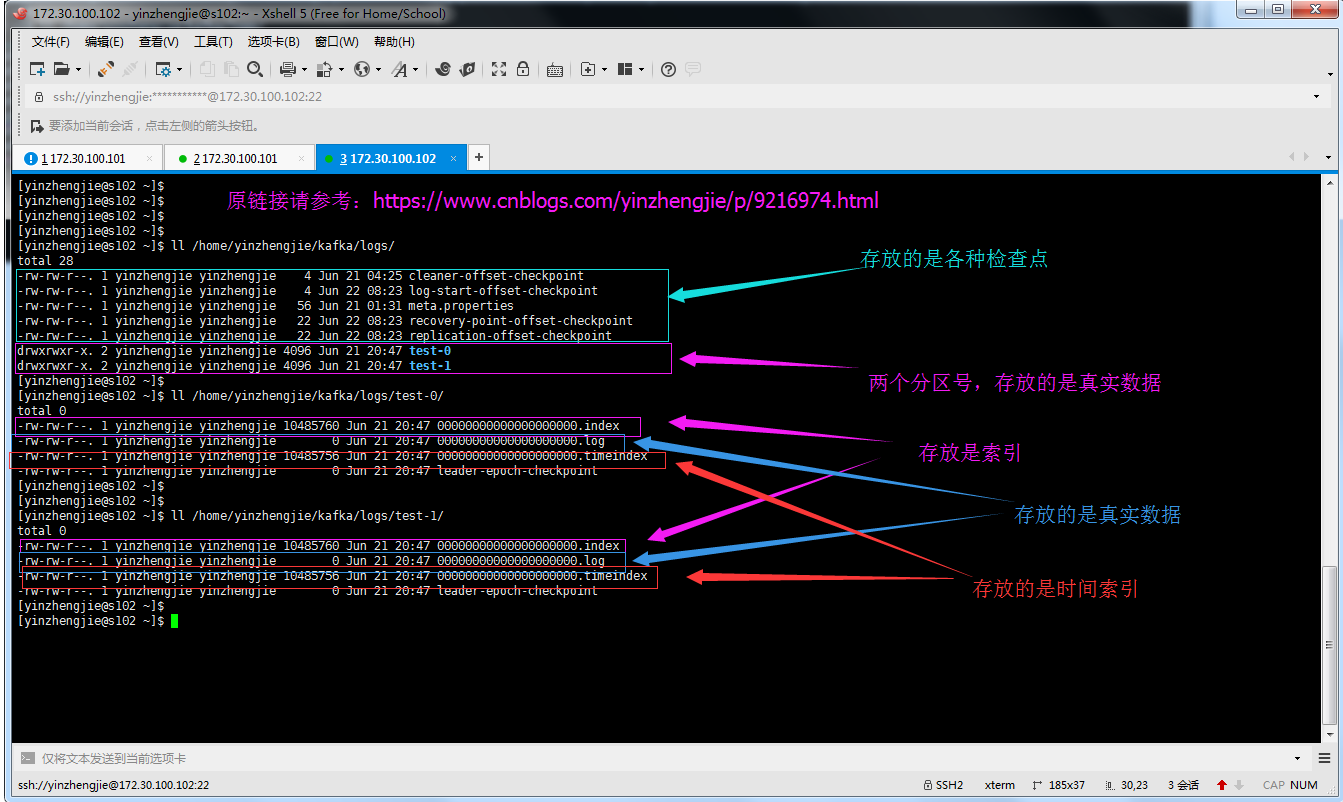Hadoop生态圈-Kafka配置文件详解
作者:尹正杰
版权声明:原创作品,谢绝转载!否则将追究法律责任。
一.默认kafka配置文件内容([yinzhengjie@s101 ~]$ more /soft/kafka/config/server.properties )
[yinzhengjie@s101 ~]$ more /soft/kafka/config/server.properties # Licensed to the Apache Software Foundation (ASF) under one or more # contributor license agreements. See the NOTICE file distributed with # this work for additional information regarding copyright ownership. # The ASF licenses this file to You under the Apache License, Version 2.0 # (the "License"); you may not use this file except in compliance with # the License. You may obtain a copy of the License at # # http://www.apache.org/licenses/LICENSE-2.0 # # Unless required by applicable law or agreed to in writing, software # distributed under the License is distributed on an "AS IS" BASIS, # WITHOUT WARRANTIES OR CONDITIONS OF ANY KIND, either express or implied. # See the License for the specific language governing permissions and # limitations under the License. # see kafka.server.KafkaConfig for additional details and defaults ############################# Server Basics ############################# # The id of the broker. This must be set to a unique integer for each broker. broker.id=0 ############################# Socket Server Settings ############################# # The address the socket server listens on. It will get the value returned from # java.net.InetAddress.getCanonicalHostName() if not configured. # FORMAT: # listeners = listener_name://host_name:port # EXAMPLE: # listeners = PLAINTEXT://your.host.name:9092 listeners=PLAINTEXT://s101:9092 # Hostname and port the broker will advertise to producers and consumers. If not set, # it uses the value for "listeners" if configured. Otherwise, it will use the value # returned from java.net.InetAddress.getCanonicalHostName(). #advertised.listeners=PLAINTEXT://your.host.name:9092 # Maps listener names to security protocols, the default is for them to be the same. See the config documentation for more details #listener.security.protocol.map=PLAINTEXT:PLAINTEXT,SSL:SSL,SASL_PLAINTEXT:SASL_PLAINTEXT,SASL_SSL:SASL_SSL # The number of threads that the server uses for receiving requests from the network and sending responses to the network num.network.threads=3 # The number of threads that the server uses for processing requests, which may include disk I/O num.io.threads=8 # The send buffer (SO_SNDBUF) used by the socket server socket.send.buffer.bytes=102400 # The receive buffer (SO_RCVBUF) used by the socket server socket.receive.buffer.bytes=102400 # The maximum size of a request that the socket server will accept (protection against OOM) socket.request.max.bytes=104857600 ############################# Log Basics ############################# # A comma separated list of directories under which to store log files log.dirs=/home/yinzhengjie/kafka/logs # The default number of log partitions per topic. More partitions allow greater # parallelism for consumption, but this will also result in more files across # the brokers. num.partitions=1 # The number of threads per data directory to be used for log recovery at startup and flushing at shutdown. # This value is recommended to be increased for installations with data dirs located in RAID array. num.recovery.threads.per.data.dir=1 ############################# Internal Topic Settings ############################# # The replication factor for the group metadata internal topics "__consumer_offsets" and "__transaction_state" # For anything other than development testing, a value greater than 1 is recommended for to ensure availability such as 3. offsets.topic.replication.factor=1 transaction.state.log.replication.factor=1 transaction.state.log.min.isr=1 ############################# Log Flush Policy ############################# # Messages are immediately written to the filesystem but by default we only fsync() to sync # the OS cache lazily. The following configurations control the flush of data to disk. # There are a few important trade-offs here: # 1. Durability: Unflushed data may be lost if you are not using replication. # 2. Latency: Very large flush intervals may lead to latency spikes when the flush does occur as there will be a lot of data to flush. # 3. Throughput: The flush is generally the most expensive operation, and a small flush interval may lead to excessive seeks. # The settings below allow one to configure the flush policy to flush data after a period of time or # every N messages (or both). This can be done globally and overridden on a per-topic basis. # The number of messages to accept before forcing a flush of data to disk #log.flush.interval.messages=10000 # The maximum amount of time a message can sit in a log before we force a flush #log.flush.interval.ms=1000 ############################# Log Retention Policy ############################# # The following configurations control the disposal of log segments. The policy can # be set to delete segments after a period of time, or after a given size has accumulated. # A segment will be deleted whenever *either* of these criteria are met. Deletion always happens # from the end of the log. # The minimum age of a log file to be eligible for deletion due to age log.retention.hours=168 # A size-based retention policy for logs. Segments are pruned from the log unless the remaining # segments drop below log.retention.bytes. Functions independently of log.retention.hours. #log.retention.bytes=1073741824 # The maximum size of a log segment file. When this size is reached a new log segment will be created. log.segment.bytes=1073741824 # The interval at which log segments are checked to see if they can be deleted according # to the retention policies log.retention.check.interval.ms=300000 ############################# Zookeeper ############################# # Zookeeper connection string (see zookeeper docs for details). # This is a comma separated host:port pairs, each corresponding to a zk # server. e.g. "127.0.0.1:3000,127.0.0.1:3001,127.0.0.1:3002". # You can also append an optional chroot string to the urls to specify the # root directory for all kafka znodes. zookeeper.connect=s102:2181,s103:2181,s104:2181 # Timeout in ms for connecting to zookeeper zookeeper.connection.timeout.ms=6000 ############################# Group Coordinator Settings ############################# # The following configuration specifies the time, in milliseconds, that the GroupCoordinator will delay the initial consumer rebalance. # The rebalance will be further delayed by the value of group.initial.rebalance.delay.ms as new members join the group, up to a maximum of max.poll.interval.ms. # The default value for this is 3 seconds. # We override this to 0 here as it makes for a better out-of-the-box experience for development and testing. # However, in production environments the default value of 3 seconds is more suitable as this will help to avoid unnecessary, and potentially expensive, rebalances during application st artup. group.initial.rebalance.delay.ms=0 [yinzhengjie@s101 ~]$
二.Kafka常用参数
1>.broker.id
答:是Kafka节点服务的唯一身份标识(和zookeeper的myid类似),,如果多台kafka节点的broker.id重复的话,那仅有一个节点可以正常提供服务。
2>.listeners=PLAINTEXT://s101:9092
答:listeners 表示监听端口,PLAINTEXT表示纯文本(也就是说,不管你发送什么数据类型都以纯文本的方式接收,包括图片,视频等等,只不过接收过来再打开的话可能会是乱码!),s101:9092表示的主机名和端口号。
3>.num.network.threads=3
答:默认的网络线程数是3。
4>.num.io.threads=8
答:默认的I/O线程是8。
5>.socket.send.buffer.bytes=102400
答:默认的套接字发送缓冲是100K。
6>.socket.receive.buffer.bytes=102400
答:默认的tao-jiezi接受缓冲是100k。
7>.socket.request.max.bytes=104857600
答:默认接收到的最大字节数是100M。
8>.log.dirs=/home/yinzhengjie/kafka/logs
答:指定存放kafka的真实数据。我这里把真实的数据存在“/home/yinzhengjie/kafka/logs”。

9>.num.partitions=1
答:默认的分区数是1。
10>.num.recovery.threads.per.data.dir=1
答:每一个文件夹默认的恢复线程是1。
11>.log.retention.hours=168
答:默认数据保存时间是168小时,即一个星期(7天)。
12>.log.segment.bytes=1073741824
答:指定每个数据日志保存最大数据为1G,当超过这个值时,会自动进行日志滚动。
13>.log.retention.check.interval.ms=300000
答:每隔300秒(即5分钟)检查日志是否过期,如果数据超过了存货日期(默认7天),就会在删除log中对应的数据。
14>.zookeeper.connect=s102:2181,s103:2181,s104:2181
答:指定zookeeper服务器,如果有多个,需要用逗号分隔。
15>.zookeeper.connection.timeout.ms=6000
答:设置zookeeper的连接超时时间(默认为6秒),如果到达这个指定时间仍然连接不上的话就默认该节点已经挂掉!
16>.
三.